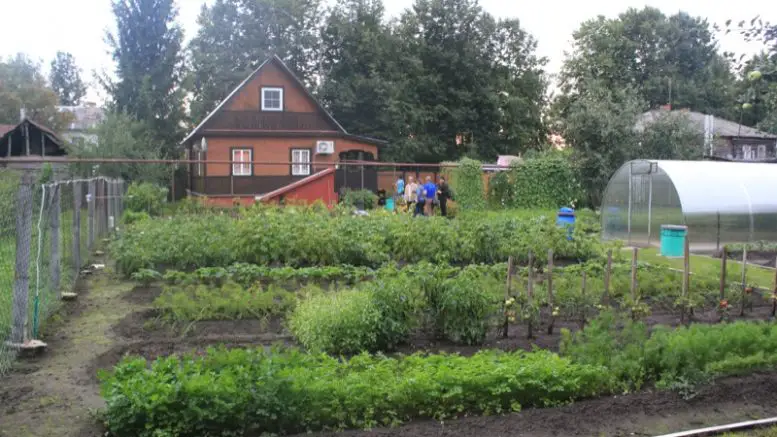The following originally appeared in Russian on Lenta.ru. The original text can be viewed, in full, here. Translation below is provided by Lindsey Greytak, a Home and Abroad Scholar focusing on translation.
This text is an interview with Alexander Nikulin, Director of the Research Center for Agricultural Studies. In it he talks about Russia’s unique demographic spread patterns in which people often maintain residences in both urban and rural areas. Historically, he says, this has given Russians greater flexibility in times of crisis. Today, however, an increasing number of Russians are beginning to favor the countryside for targeting their career and investment choices.
Russia “Empties from Within”
Urban populations are flocking to the countryside.
This will save Russia from collapse.
Sociologists are calling the exodus of urban populations moving from the city to the countryside a new trend in Russia. In some regions, “de-urbanization” may reach up to ten percent of the population.
Lenta.ru: Is it true that urban populations are really moving to the countryside?
Nikulin: Today we can see a second wave of urban population beginning to move to rural places. Moreover, they are not moving just to survive, like it was in the first wave in the beginning of the 1990s. This wave is moving with a plan. Many open their own family business. They are looking for their own original niche of economic activity.
But is agricultural production a logical career choice? Breeding cows, pigs, and planting potatoes?
After 2000 in the regions, particularly those located near major cities, populations began to grow like cultivated mushrooms. Then, the dollar-ruble exchange rate dropped to a level attractive to agricultural investors. It became difficult to for owners of personal subsidiary farms to compete with gigantic agricultural business owners. Therefore, many are now turning to boutique operations, where the levels of concentration and scalability aren’t attractive enough for big business.

The Russian countryside still lacks investment, but new arrivals from the cities are beginning to bring innovation. Russians typically have high levels have self-reliance, according to recent polls.
For example?
Tens of thousands of birds, pigs, cows, etc. are usually bred in agro-holdings in “factory farms.” But goats? Goats need to be handled in small numbers. Goat factory farms do not exist. Therefore, private traders in goat breeding have certain advantages. In the Saratov Oblast there is a wonderful farmer, Yuri Karamzin. In the 1990s he lived in Spain and learned how they produce cheese. Then he returned to Russia. Now, 80 kilometers outside of the city, in the village of Lokh, elite goat shepherds are engaged in cheese production using Spanish techniques and their own recipes. The farm then sells their cheese to prosperous customers in Saratov.
Are people still engaged in private gardening?
The intensity of gardening depends on the region. In some places it is advantageous and other places it is not. Let’s take the Lipetsk Oblast; it is a beautiful potato-growing region. In the 1990s many residents there collectively grew potatoes on individual plots (ed: usually in private gardens without machinery, fertilizer, etc.). Apparently, they made good money on this. In the fall they would hire a truck and bring their harvests to Moscow. But now this is becoming unprofitable. This is because chain stores are beginning to open, even in villages with three or four thousand residents. Even in these villages, the prices for Israeli potatoes are lower than those the Lipetsk gardeners could offer for their goods. (ed: because the Israeli product is massproduced and the Lipetsk product is not.)
But many rural-urban economies are actively restructuring in search of new niches. Here, those migrating from cities are driving the change, initiating something new. They cultivate, let’s say, special varieties of potatoes, with tastes that no store can equal. Many such local enterprises are engaged in harvesting berries, mushrooms, and fish. When you drive between Moscow – Vologda – Arkhengelsk, everywhere along the roads you are offered wild plants and homemade food in jars. Small scale production, in contrast to mega-production, focus on the quality of the goods. If, for example, the product is from the garden, the emphasis in put on environmental friendliness, and the refusal to dangerous chemicals.
But this is just what they say – do they have documentation to confirm their environmental friendliness?
The fact is that the entire informal economy of the small-scale producers is based on this trust. It acts as a social capital, and the owners of these enterprises value their reputation. Their market depends on this. It is enough that if you sell low-quality products once, it’s over, it is easy to lose your personal clients.

Alexey Dubovets adjusts smoked Scamorza cheese at a storehouse of his family dairy and cheese farm in the Siberian village of Sizaya, south of Krasnoyarsk, Russia. He is an example of someone who moved from the city to invest in agriculture.
Can you assess the scale of de-urbanization? How much of the urban population is moving to the countryside?
Exactly how many is hard to say. Now everyone is mobile, and transport connections are very developed. Today you are an urbanite, tomorrow a villager. That is, it is impossible to talk about the autonomy of cities and villages. Once, a classic Russian sociologist Pitirim Sorokin proposed a term for this phenomenon: rural-urban continuum.
For instance, according to statistics, in Russia there are 150 thousand rural settlements. However, 30 thousand of them are only listed on paper. They have no permanent residents. Of these, about 10-12 thousand, however, come back to life with summer residents. According to our expert estimates, depending on the regional share of the urban population that also has rural employment, this number may be as much as seven to ten percent of the total number of rural residents
Is this a lot or a little?
It doesn’t exceed the outflow of the native populations from the villagesof course. Many more of those currently counted among the rural population, are actually employed in the cities.
But at the same time, the urban populations migrating to the villages is sufficient enough to give a push towards positive change in the countryside. The level of employment in villages is increasing, forming a base for agro-tourism. Even summer residents now have an interest in seeing the villages cared for. With what resources they have, residents help to do something with the abandoned houses that surround the landscapes.
So, it seems that the original populations no longer live in the villages?
It really depends on the region. The rural social landscape is really changing. Rural economies are diversifying. It started in the 1990s. Now the process is increasing. The cultivation of gardens is occurring less often; instead people are more engaged in the maintenance of dachas, construction, etc. Often, these long-time residents leave to work part-time in the big city. They usually work on a rotational basis: a month or two away, then a short break at home, and again return to work.
We recently compared our rural development with China’s with Chinese scientists. The Chinese scientists said that their population in divided into three parts: rural China, urban China, and Chinese migrants. The same can be said about Russia. Internal migrants from Russian villages are now a powerful army – there are millions of them. They are an important element of the informal rural economy. They invest the money they have earned in support of the development of their households.
By the way, when the crisis came, some villagers who worked in the city lost their jobs and returned to the countryside. They restarted their personal plots there, but now using modern urban technologies. Agriculture around the world today is one of the most innovative industries.
There are many stereotypes that say that the countryside and technology are incompatible.
A hundred years ago basically everything was like this. But today if we look at labor productivity and agricultural equipment, we find that there is often technical and economic superiority in modern agrarian enterprises over those in many urban industries.
In the 1920s, the tractor produced at the Ford factory was more primitive than a car of any brand. Today, a modern Fendt tractor, for example, is technologically more advanced and costs more than a Mercedes or BMW. A modern agro holding is many times more productive than the former collective and state farms, although this is also a double-edged sword. In a capitalist economy, the growth of labor productivity throws superfluous people out on the street.

Olga Korogodina and Daniel Lawrence opened a small greenhouse business to supply Moscow with specialty greens. An increasing number of foreigners are beginning to invest in agriculture in Russia as well.
Has innovation reached personal plots?
We are now just beginning to study this process. Progress doesn’t care who it benefits: an agro holding or private household. Many remember what kind of greenhouses people had on their personal plots in the 1990s. Some people built them out of window frames, even from the skeletons of old iron beds; some covered the green houses with a cellophane film. Now, if you drive through the regions, you can see that practically in all of Russia there are standard and convenient technological greenhouse constructions of various sizes. You can buy kits in large stores or even order them online.
Practically any modern high-performance and reliable gardening equipment can be purchased; although only fairly well-off households can afford it. But it is good that the process of technical re-equipment for such personal plots is gaining momentum.
The state could very well support the rural population in this regard. A delegation from our institute went to China. The average land plot of a Chinese farmer is about 14 hectares (34.5 acres). That is, it is similar to the size of a typical Russian private plot. Local authorities help the Chinese farmers with tools, equipment, and even equip their facilities with solar batteries. As a result, labor productivity is increasing for these small forms of agriculture. In addition, the Chinese state tries to carry out a guaranteed purchase of agricultural products from farmers through special cooperatives. In Russia, those working personal plots often do not know where or how to sell their goods.
In Russia, how is the relationship between the “new countryside” and the state? Especially if they are trying to engage in under-the-table business?
Until recently, the state turned a blind eye to the informal rural-urban economy. There was, to a large extent, a problem of depressed regions and rural poverty due to low salaries in rural areas. The informal economy allows households to deal with these problems quite well.
But now, more and more officials are saying it is time to restore order. Looking at just one farm, the economic impact seems microscopic, but if there are millions of such farms? Orders are given to bring the informal rural economy of the village out of the shadows.
But here there is a need for a differentiated approach. An old women who grows onions and garlic for herself and her grandchildren is one thing – and the handymen and construction workers are another. They are not legalized anywhere to work, although they earn quite a bit of money.
After the war, under Stalin, the state sought to impose taxes on any type of product that was produced on private plots. Then, in response, production in the countryside began to decline. As a result, the villages were very tight on money, and the state saw revenues decline from this.
Are you able to assess the turnover of these personal plots and their contribution to the economy?
Detailed statistics do not exist. It is all in a grey zone. The villagers themselves prefer not to deal with the government, and do not provide information about their dealings.
We try work with those fragments official data available from the state. According to the All-Russian Agricultural Census conducted in 2006, family households produced 57.3 percent of all agricultural products made in Russia. Looking at individual entries, private plots accounted for 92 percent of potatoes grown in Russia, 77 percent of vegetables, fruit, and berries, and 88 percent of honey. That is, with the exception of milk, meat, poultry, and grain, many types of agricultural products in our country are still being produced on private plots.
In the last decade, of course, the private plots have reduced production, but have diversified into crafts, tourism, recreation, and ecology.
The modern village is not dying, but possibly flourishing?
The fortunes of countryside go up and down, are almost always difficult, but the vital activity of the rural-urban population of the Russian provinces is as ineradicable as nature itself. Our geographers carried out research on rural settlements. The countryside disappeared by leaps and bounds in the late Soviet period between 1960-1980. There was massive urbanization and industrialization in cities where working hands were constantly needed. Now everything to a large extent has stabilized. Villages are disappearing less than they did in the Soviet times. The main reason being that many villages ceased to exist in the second half of the 20th century, and the rest are located mainly near large cities and on fertile lands.
Unfortunately we have lost our once relatively widespread resettlement network in Russia. Now there are only archipelagoes of rural settlements near large cities, and between them the former farmland has overgrown with forest. The country is emptying from within, and the authorities need to take care of this problem. It is not just about food, but also about the geopolitical security of the country.
I’m guessing the security problem concerns more the border territories of the country? Like the Far East?
Even our Nyechyornozyeme Region (ed: litterally the “Non-Black-Earth Region,” a name for a large swath of north-western Russia, which actually includes Moscow) is empting, not just the Far East. If we were to give away those free hectares (ed: the Russian Homestead Act) in the Nyechyornozyeme Region, there would be even more takers. That could really revive the Russian countryside.





